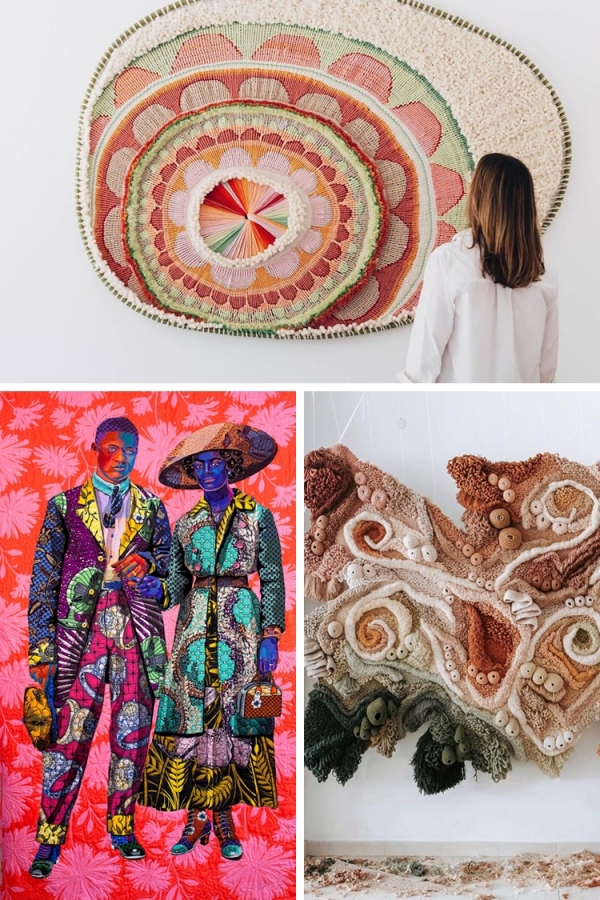Textiles have a long place in art history. The combination of textiles and art can be traced back to ancient times when it was primarily used to clothe people or keep them warm. But as trade routes were established and production techniques improved—particularly during the Industrial Revolution—artisans and artists began experimenting with creative expression with the likes of fabric, thread, and yarn.
Many artists who create groundbreaking textile work are women. It should come as no surprise; textiles are often relegated as crafts, and crafts are often seen as “women’s work.” But because these artworks tend to skew heavily female, amazing artists don’t get the recognition they deserve. This is slowly changing as attitudes towards art continue to shift.
To celebrate Women’s History Month, we’ve highlighted five amazing contemporary textile artists who use their work to shine a light on marginalized people, the state of the environment, the power of intuition, and more.
Check out these contemporary textile artists to celebrate during Women's History Month.
Artist Bisa Butler treats quilting like painting to create incredible fabric portraits. Colorful swatches of prints and patterns offer a contemporary twist on historical representations of Black men, women, and children. In creating these massive pieces, she is helping to tell the stories of people who have been forgotten or completely overlooked.
To create her incredible quilt art, Butler layers fabrics and pieces every element together—down to a tiny glint on an eye. If this sounds like a meticulous process, it is. Some of her larger quilts, which measure over seven feet, can take her over 200 hours to complete. She finishes her work on a long-arm quilting machine.
Butler’s work sheds light on what is dimmed in the scope of history. “My community has been marginalized for hundreds of years,” she explains. “While we have been right beside our white counterparts experiencing and creating history, our contributions and perspectives have been ignored, unrecorded, and lost. It is only a few years ago that it was acknowledged that the White House was built by slaves. Right there in the seat of power of our country African Americans were creating and contributing while their names were lost to history.
“I am inviting a reimagining and a contemporary dialogue about age-old issues, still problematic in our culture, through the comforting, embracing medium of the quilt. I am expressing what I believe is the equal value of all humans.”
Portuguese artist Vanessa Barragão produces homages to the ocean. This is not only in her imagery—with creations that look like coral reefs—but in the materials that she chooses.
Barragão’s textured rugs, tapestries, and wall hangings utilize discarded textile waste as a way to offset the detrimental environmental effects that this industry creates. “The textile industry is one of the most polluting in the world,” she writes. “In almost the entire process, chemicals are used, especially when it comes to the fibers treatment and dyeing, besides that all the machinery used requires tons of energy which is extremely harmful to our planet.”
Using approaches including latch hook, crocheting, embroidery, knitting, and more, the various techniques translate into beautiful work that implores us to consider how we treat the planet before it’s too late.
Sweden-based artist Ulla Stina-Wikander transforms old household objects and turns them into art. She takes outdated technol—such as mixers, irons, and sewing machines—and covers them in vibrant cross-stitch designs.
The cross-stitch textiles are themselves things she finds from flea markets and vintage stores. By using them in this contemporary fashion, she is celebrating the women who created them by hand. Their beautiful work goes uncredited, as cross stitch and other embroidery are often disregarded as simply being “women’s work.” In Stina-Wikander’s format, however, they take on new meaning.
“Covering is a slow process and I am very meticulous because I want to pay tribute to the women who have made the embroideries and also because I have a bad conscience for cutting them up,” she explains to My Modern Met. “I want people to take a better look at the things we throw away, the things that are regarded as useless. My items become artifacts from a bygone era, disguised, dressed, and camouflaged. I give them a second life in a new context.”
Artist Simone Saunders focuses her visual arts practice on rug-hooking, tufting, and weaving to create large-scale portraits. The textures we typically associate with floor coverings take on a new, often more urgent meaning.
“[Her] textiles engage upon a search for belonging,” her website states, “studying the Black female body, personal identities and a connection to Black history.” The colorful works utilize text and motifs including big cats and cobra snakes. “Repetitive ideologies of powerful creatures are embedded as talismans within Simone’s work: enhancing upon otherness and the Black body’s relation rooted in a kinship of power and survival. Simone creates narratives through cultural mythology, history, and personal landscapes.”
Artist Tammy Kanat thinks beyond the conventional rectangular loom to create massive organic shapes. The pieces often resemble nature. Some of her most recent creations look like flowers blooming on the wall with tantalizing combinations of earthy hues, wrapping, fringe, and knots.
Kanat is deeply connected to her art, and it is reflected in her textiles. “For me, weaving projects a mood,” she explains. “I follow my instinct to create designs that feel balanced. I am very visual, always taking note of my surroundings and believe this is reflected in my work.”
She is also open to experimentation and allows everything to unfold naturally. “My work is intuitive, there are no plans, it just evolves and my hands start to dance with the threads,” Kanat reveals to My Modern Met. “I am always curious and try to change my techniques and patterns and continue to explore.”
---
***Resource:https://mymodernmet.com/textile-artists-womens-history-month/
***Author:SARA BARNES


